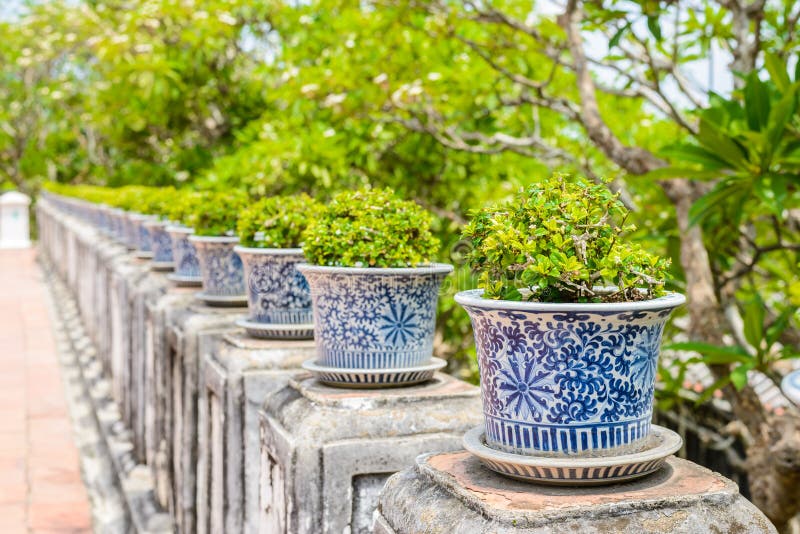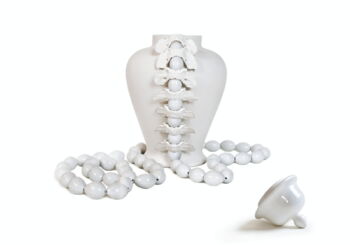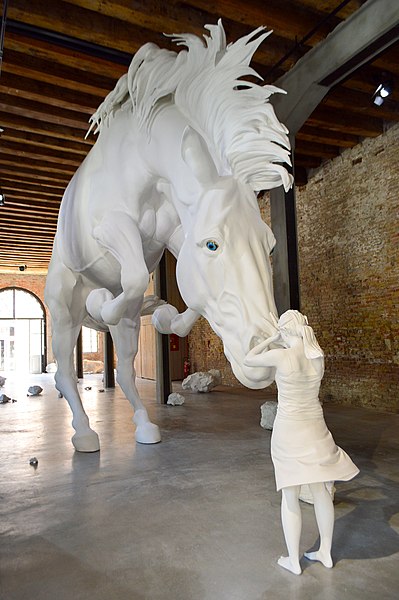Porcelain, invented during the Han dynasty (206 BC – 220 BC) at Ch’ang-nan, China, has been used throughout humankind’s history to create a variety of durable objects known for their translucent and lasting finish.

image source : https://en.wikipedia.org/wiki/Porcelain#/media/File:Chinese_-_Flask_-_Walters_491632_(square).jpg
Main categories
- Hard-paste: made of quartz, kaolin, and feldspar (a mineral comprising mostly aluminium silicate) to produce porcelain of great hardness, translucency, and strength;
- Soft-paste: made of kaolin, quartz, nepheline syenite, or other feldspathic rocks. It’s generally fired at lower temperatures therefore these wares are less hard than hard-paste porcelains.
- Bone China: made of bone ash, feldspar, and kaolin. It’s the strongest amongst all types of ceramics and it’s known for its whiteness.

image source : https://en.wikipedia.org/wiki/Porcelain#/media/File:Fonthill_vase_by_Barthelemy_Remy_1713.jpg
Production process
- Crushing and mixing: at the beginning of the production process, a combination of minerals is grinded using jaw crushers or mills. To create different types of porcelain, craftspeople combine raw materials in varying proportions to obtain the desired colors, thermal qualities, and finish specifications. After a cleaning process to remove improperly sized materials, the powdered minerals are mixed with water to make a wet paste called slip, which is also pressed through a series of screens to further filter the paste.
- Forming the body: porcelain objects can be made using all the shaping techniques used for pottery. Slipcasting has been the most common commercial method in recent times: plaster molds are filled with fresh slip to make sure the pores of the mold can absorb as much water as possible, leaving a thin layer of hardened slip when the molds are emptied. Once the slip has completely air dried, the molds can be peeled off the porcelain piece, which is hard enough to be handled without losing its shape, but it’s also soft enough to be modified.

image source : https://nirogranite.com/blog/2020/08/02/how-are-porcelain-tiles-produced/
- Firing and Glazing: after being formed, porcelain often receives underglaze decoration using pigments to overglaze enamels, allowing a wider range of colors. Like many earlier wares, modern porcelains are then biscuit-fired at around 1,000 °C (1,830 °F) to vaporize volatile contaminants and minimize shrinkage during the next step of firing. After being coated with a glaze, the porcelain pieces are sent back for a second firing at a temperature of about 1,300 °C (2,370 °F) or more in a kiln, to permanently set their shapes and vitrify the glaze.
When was porcelain discovered?
Hard-paste porcelain originated in China during the T’ang dynasty (618-907 A.D.). By the time of the Ming dynasty (1368–1644 AD), porcelain wares such as the coveted “blue-and-white” ware, were being exported to other areas of Asia, Africa, and Europe via the Silk Road. The European imitation of Chinese artistic traditions led chinoiserie to enter European homes and expositions in the 17th century: its popularity peaked around the middle of the 18th century when it was associated with the Rococò style.
What are the characteristics that make porcelain popular to this day?
- Even if the vitreous and translucent exterior makes it look delicate, porcelain is the hardest ceramic clay ever used;
- Porcelain combines glass’s low porosity with clay’s ability to retain its shape when heated, making it both easy to form and ideal for domestic use;
- It’s used in electrical isolators and other industrial or medical applications thanks to its isolating properties;
- Porcelain polish has higher scratch resistance than paint, which is why it’s used from architectural applications (subway walls, school marker boards, and signage) to home appliances and fixtures (barbecues, ovens, fireplaces, etc…);
- Porcelain coatings are used in applications where a bonded surface is required because of its higher temperature resistance and better tolerance to corrosion and staining.
 Row of bonsai,Siamese rough bush in the porcelain pots
Row of bonsai,Siamese rough bush in the porcelain potsContemporary porcelain works
Vertebra – Stackable candleholder of enameled porcelain by Célia Nkala (2011)


images source : http://celiankala.com/artworks/ossements/index.php?l=en
![r/SculpturePorn - Claudia Fontes - Abstract Masses of Porcelain Consume Embracing Figures [750x886]](https://preview.redd.it/gdkdn6cqcuf61.png?width=640&crop=smart&auto=webp&s=c5cd5e68e21024d000220202e29adb91f8d1b28e)

image source : https://commons.wikimedia.org/wiki/File:Claudia_Fontes_Argentina_(230460757).jpeg
Info sources:
http://www.madehow.com/Volume-1/Porcelain.html
https://www.britannica.com/art/porcelain
https://en.wikipedia.org/wiki/Porcelain
